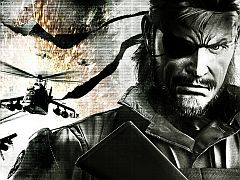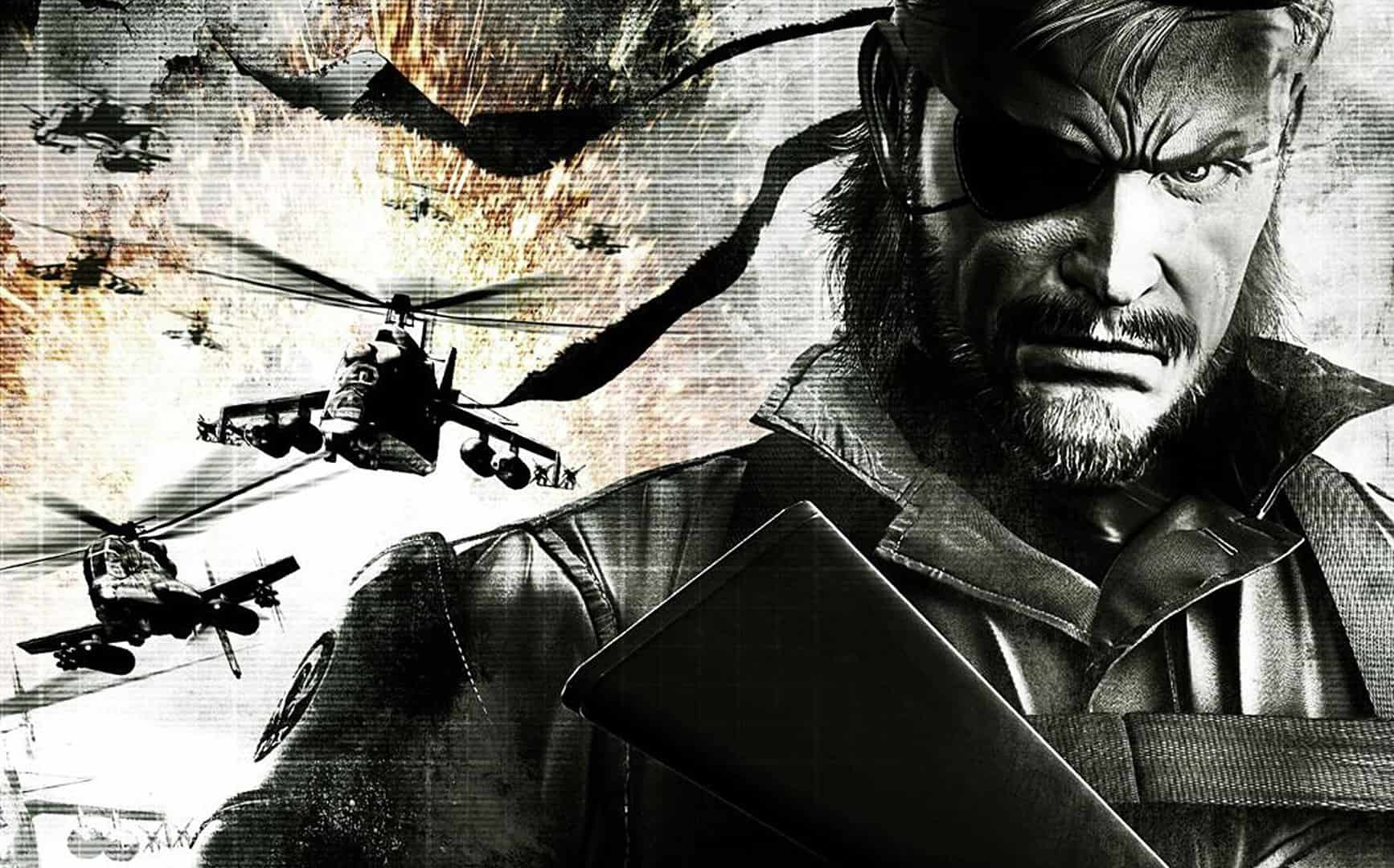You can trust VideoGamer. Our team of gaming experts spend hours testing and reviewing the latest games, to ensure you're reading the most comprehensive guide possible. Rest assured, all imagery and advice is unique and original. Check out how we test and review games here
Peace Walker is more than a game of two halves; it is a game of two cultures. It is the perfect Japanese PSP game, but the imperfect Western PSP game.
We’re told it began life as Metal Gear Solid 5, but was later condensed to fit Sony’s portable console. Certainly, the plot bears all the hallmarks of a main Metal Gear yarn. Naked Snake, circa a Cold War-fuelled 1974, is the leader of a band of mercenaries called ‘Militaires Sans Frontières’, or Soldiers Without Borders. He is hired to help a rebel force boot the CIA out of Costa Rica, but ends up having to stop a demented professor from blowing up the world with a nuclear missile-carrying bipedal tank.
Missions come in two flavours: Main Ops are story missions, which are either sneaking missions or boss battles, and Extra Ops are repeatable challenges, designed to test your skills. Separate from the third-person sneakery pokery is a resource gathering management sim. After around about the first hour of play, Naked Snake and his cohorts settle down in an oil rig called Mother Base. As leader, it’s Snake’s responsibility to sort the new recruits that turn up on his doorstep into one of five teams: combat units, R&D, Mess Hall, Medical and Intel. Duties include making sure there are enough cooks in the Mess Hall to feed your workforce, tending to wounded soldiers in the sick bay and sending the riff raff to the brig.
As you progress through the game, Mother Base expands and new features are unlocked. Outer Ops, for example, is where you send combat units to fight other combat units in conflict zones across the world. Each unit has six slots, which you can fill with infantry and mechs (tanks and helicopters and unmanned bipedal robots, that sort of thing) before dispatching them to fight the enemy team. After you’ve progressed time by finishing a sneaking mission, your units return from the battlefield and you get to watch the fights they’ve had as weird turn-based scraps over which you have no control. Hopefully, your victorious team returns with the spoils of war free from injury (you get funny messages like ‘Red Seabream transported to Sickbay due to post traumatic stress disorder’). But watching this play out is like watching someone play a really basic version of Advance Wars. Or, in other words, like watching paint dry.
Managing Mother Base is essential to your success during Main Ops missions, and it greatly extends the game’s lifespan, but it feels like mindless work – a bit like stacking shelves. You care about the level of your Intel team because the higher it is, the more supplies you can call in when the going gets tough out on the battlefield. You want your combat teams to win Outer Ops missions because if they do they bring in loads of GMP, the currency used to buy research, which unlocks essential gadgets like night vision goggles and upgrades for the tranquilliser gun. But it’s all necessary, rather than fun. You engage with Mother Base, but it’s never engaging.
The main missions are where it’s at, then. And this is where Peace Walker is sure to divide opinion.
Let’s talk about controls. Some believe the failure of the PSP in the West is in part due to the lack of a second analogue nub. When it comes to third-person shooters, which Metal Gear Solid is in part, this is particularly troublesome. Without a second analogue nub, camera control is mapped to the face buttons (the default scheme, called Shooter Style), or, if using the alternative control schemes, the d-pad. Either way, you’re in for a world of hurt. Trying to accurately aim a targeting reticule with the face buttons is almost impossible. Trying to keep an enemy helicopter in view when soldiers surround you is an exercise in frustration. The controls are better than they have been in previous Metal Gear games, not least in Portable Ops, so Kojima scores points for trying (you can move and shoot while in the over the shoulder view). But, frankly, the PSP is an awful console for third-person shooters. In Peace Walker, you’re not just battling the camouflaged snipers and bipedal robots you can see in the PSP’s lovely screen, you’re battling the shiny plastic you’re holding in your hands.
After extended play, however, you do start to cope – never to the point of satisfaction – but you start to cope. It’s at this point Peace Walker’s fatal flaw presents itself: co-op, or, as will be the case for 99 per cent of Western players, the lack thereof. Peace Walker is a game designed from the ground up to be played co-operatively, either two-player or four-player. As such, the levels have been crafted to suit more than one sneaky snake slithering around their virtual nooks and crannies.
The influence is clear: Monster Hunter. For those not in the know, Monster Hunter is a co-op focussed third-person fantasy action game which has seen huge success in Japan. In Japan, players connect their PSPs wirelessly at train stations and in parks, teaming up to battle huge dragon-like creatures for shiny new loot. In Japan, Monster Hunter is a phenomenon. Obviously Konami and Kojima Productions have noticed.
Peace Walker works similarly to Monster Hunter, warts and all, and it’s not ashamed to admit it. One of the alternate control schemes is called ‘Hunter Style’. One of Snake’s chums, a brain-meltingly annoying young Nicaraguan boy called Chico, bangs on endlessly about mythical beasts. The sneaking missions are divided up into maps linked by lines, like in Monster Hunter. When you’re playing with friends you can share items on the battlefield, resurrect other players and even drive cardboard boxes that work like little tanks (that last bit’s not in Monster Hunter, obviously).
The problem is not that you can play the game with others. The problem is that the game is at times unplayable on your own. In designing Peace Walker’s missions to be challenging for multiple players, Kojima has made some of them incredibly difficult to solo. This is no more apparent than during the boss fights, or, as I like to call them, the soul-destroying battles of attrition that are so hard they make you long for an existence spent rocking back and forth on a chair made of a material you’re allergic to and with spikes coming out of the bit you sit on.
An example: I spent over two hours dying against a tank. After seeking out a video of the fight on the internet (it was more a cry for help), I learned that the best tactic is to throw a smoke grenade at the soldiers that protect it, run up to them, make them eat dirt by aiming my tranquilliser gun from right behind them, then tie balloons to them to extract them from the battlefield (a fun new feature called Fulton Recovery). Then, hopefully before the tank spots me, I should run away and hide, waiting for the next set of soldiers to spawn. Rinse, lather and repeat until all the soldiers are extracted and the tank driver pops his head out of the impenetrable armour, allowing me to put a bullet through his very penetrable skull.
That boss fight, though, was a walk in the park compared to the one against a Hind chopper. It circles a jungle clearing, bombards you with missiles while spawning soldiers that move in for the kill. Again, after hours of endless death, I headed online for salvation. And again, I discovered that the best tactic is to chuck a smoke grenade at the enemy troops and Fulton them away. 20 soldiers later, the pilot should pop his head out. That’s where the sniper rifle comes in.
Peace Walker’s punctuated by horrendous difficulty spikes. Horrendous difficulty spikes. But they’re only horrendous difficulty spikes if you’re playing on your own. If you’re playing with others, you know, the way the game is meant to be played, they’re loads of fun. If you’re playing with others, Peace Walker is one of the best games on the PSP, if not the best; a magical fusion of stealth, guns and teamwork.
For me, multiplayer gaming on my PSP isn’t an option. I imagine it’s the same for most Western owners of the console. In Japan, everyone has a PSP. In Japan, the odds are on that you’ll bump into a like-minded gamer at a crowded train station, someone who’ll be happy to help you complete one of the horrendous difficulty spikes you’ve just spent the last hour bashing your head against. Then, I imagine, two unattainably attractive girls cos-playing as characters from Final Fantasy VII sit next to you and your Otaku chum, wirelessly join in your game, then invite you back to their flat where you discover that the world is in fact a hentai Manga in which you hunt tentacle monsters. Probably.
There is the option of playing online, but you have to own a PS3 to access it, via what’s called “ad hoc party”. The system is incredibly fiddly to get going and not particularly user-friendly once you do. And in any case, being forced to own a PS3 to play Peace Walker the way it’s meant to be played is offensive. I shouldn’t have to own a PS3 to get the most out of a PSP game.
It’s a crying shame, because horrendous difficulty spikes aside, Peace Walker is great. It has all the blisteringly beautiful visuals, impressive production values and rewarding stealth gameplay you expect from a Metal Gear game. The sneaky missions that lead up to the boss fights are, mostly, superb, and focus on what’s great about the series: patrol memorisation, playing smart, and the immense satisfaction gained from getting through an area without triggering that iconic exclamation mark sound effect.
If you hate Metal Gear Solid and everything it stands for (I’m convinced no-one actually knows what it stands for at this stage), Peace Walker will reaffirm your hate like the Daily Mail reaffirms 50-year-old women’s hate of messy houses. The story is often embarrassingly juvenile (at one point you can zoom in to see a 16-year-old girl’s underwear), the dialogue is terribly written, and there are lots, and lots, and lots, of long, mind-numbing cutscenes packed with pointless exposition (listen to the countless briefing tapes if you’re having trouble sleeping). But weirdly these are all Kojima trademarks fans are sure to lap up.
If I were reviewing Peace Walker for Japanese gamers, I would have given it a higher score. But I’m not. I’m reviewing it for Western gamers – more specifically British gamers. In Britain, we do not play our PSPs together on the bus, train or tram (unless we like stabs in the face). In Britain, we do not play our PSPs online (unless we’re the hardest of the hardcore). The ugly truth is that in Britain, we hardly play our PSPs at all. With luck, Konami will release Peace Walker as a PSN game.
Metal Gear Solid: Peace Walker
- Platform(s): PlayStation 3, PS Vita, PSP, Xbox 360
- Genre(s): Action, Adventure

/https://oimg.videogamer.com/images/44d4/mgs_peace_walker_71.jpg)
/https://oimg.videogamer.com/images/8c44/mgs_peace_walker_70.jpg)
/https://oimg.videogamer.com/images/8ae9/mgs_peace_walker_69.jpg)
/https://oimg.videogamer.com/images/fd7e/mgs_peace_walker_19.jpg)
/https://oimg.videogamer.com/images/ef0a/mgs_peace_walker_47.jpg)
